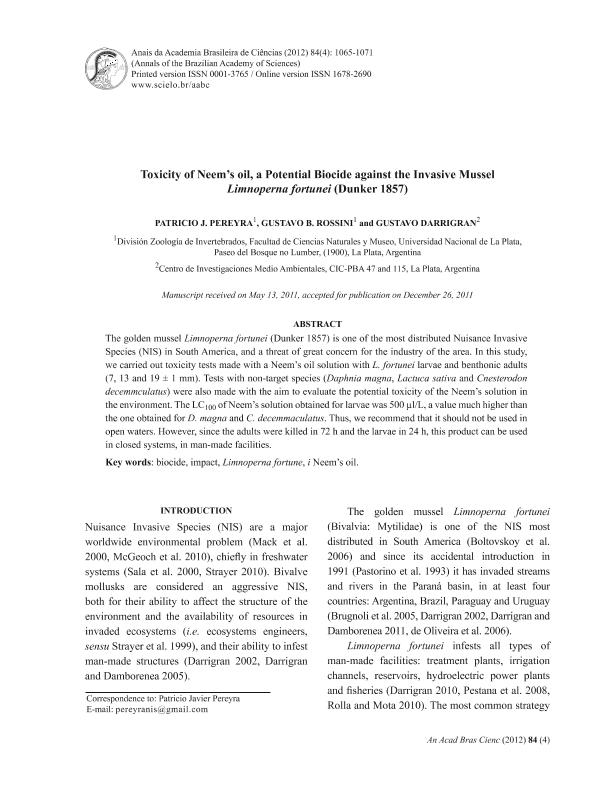Mostrar el registro sencillo del ítem
dc.contributor.author
Pereyra, Patricio Javier

dc.contributor.author
Bulus Rossini, Gustavo Daniel

dc.contributor.author
Darrigran, Gustavo Alberto

dc.date.available
2016-12-19T20:16:59Z
dc.date.issued
2012-12
dc.identifier.citation
Pereyra, Patricio Javier; Bulus Rossini, Gustavo Daniel; Darrigran, Gustavo Alberto; Toxicity of Neem’s oil, a potential biocide against the invasive Mussel Limnoperna fortunei (Dunker 1857); Academia Brasileira de Ciencias; Anais Da Academia Brasileira de Ciencias; 84; 4; 12-2012; 1065-1071
dc.identifier.issn
0001-3765
dc.identifier.uri
http://hdl.handle.net/11336/9779
dc.description.abstract
The golden mussel Limnoperna fortunei (Dunker 1857) is one of the most distributed Nuisance Invasive Species (NIS) in South America, and a threat of great concern for the industry of the area. In this study, we carried out toxicity tests made with a Neem’s oil solution with L. fortunei larvae and benthonic adults (7, 13 and 19 ± 1 mm). Tests with non-target species (Daphnia magna, Lactuca sativa and Cnesterodon decemmculatus) were also made with the aim to evaluate the potential toxicity of the Neem’s solution in the environment. The LC100 of Neem’s solution obtained for larvae was 500 µl/L, a value much higher than the one obtained for D. magna and C. decemmaculatus. Thus, we recommend that it should not be used in open waters. However, since the adults were killed in 72 h and the larvae in 24 h, this product can be used in closed systems, in man-made facilities.
dc.description.abstract
O Mexilhão dourado Limnoperna fortunei (Dunker 1857) é uma das espécies invasoras melhor distribuídas na América do Sul, sendo motivo de grande preocupação para a indústria local. Neste estudo, nós realizamos ensaios de toxicidade de soluções de Óleo de Neem em larvas e adultos bentônicos de L. fortune (7, 13 e 19 ± 1 mm). Com o objetivo de avaliar o potencial tóxico do Óleo de Neem no ambiente também foram realizados testes com organismos não alvo (Daphnia magna, Lactuca sativa e Cnesterodon decemmculatus). A LC100 da solução de Neem para larvas foi 500 µl/L, um valor muito superior ao obtido para D. magna e C. decemmaculatus. Desta forma, nossa recomendação é que este óleo não deve ser utilizado em ambientes naturais abertos. No entanto, uma vez que os adultos morreram em 72h e as larvas em 24h, este produto pode ser utilizado em sistemas fechados construídos pelo homem.
dc.format
application/pdf
dc.language.iso
eng
dc.publisher
Academia Brasileira de Ciencias

dc.rights
info:eu-repo/semantics/openAccess
dc.rights.uri
https://creativecommons.org/licenses/by-nc-sa/2.5/ar/
dc.subject
Biocide
dc.subject
Impact
dc.subject
Limnoperna Fortunei
dc.subject
Neem'S Oil
dc.subject.classification
Otros Tópicos Biológicos

dc.subject.classification
Ciencias Biológicas

dc.subject.classification
CIENCIAS NATURALES Y EXACTAS

dc.title
Toxicity of Neem’s oil, a potential biocide against the invasive Mussel Limnoperna fortunei (Dunker 1857)
dc.type
info:eu-repo/semantics/article
dc.type
info:ar-repo/semantics/artículo
dc.type
info:eu-repo/semantics/publishedVersion
dc.date.updated
2016-12-12T14:36:32Z
dc.identifier.eissn
1678-2690
dc.journal.volume
84
dc.journal.number
4
dc.journal.pagination
1065-1071
dc.journal.pais
Brasil

dc.description.fil
Fil: Pereyra, Patricio Javier. Universidad Nacional de la Plata. Facultad de Cs.naturales y Museo. Catedra de Zoologia de Invertebrados I; Argentina. Consejo Nacional de Investigaciones Científicas y Técnicas; Argentina
dc.description.fil
Fil: Bulus Rossini, Gustavo Daniel. Universidad Nacional de la Plata. Facultad de Cs.naturales y Museo. Catedra de Zoologia de Invertebrados I; Argentina
dc.description.fil
Fil: Darrigran, Gustavo Alberto. Provincia de Buenos Aires. Gobernación. Comisión de Investigaciones Científicas; Argentina. Consejo Nacional de Investigaciones Científicas y Técnicas; Argentina
dc.journal.title
Anais Da Academia Brasileira de Ciencias

dc.relation.alternativeid
info:eu-repo/semantics/altIdentifier/url/http://ref.scielo.org/cbs862
Archivos asociados
